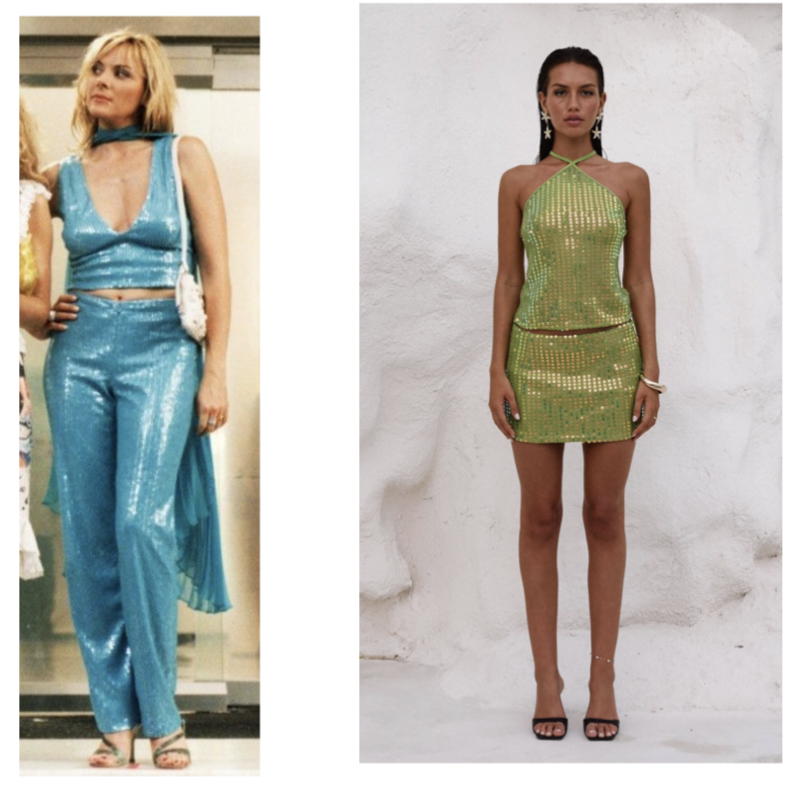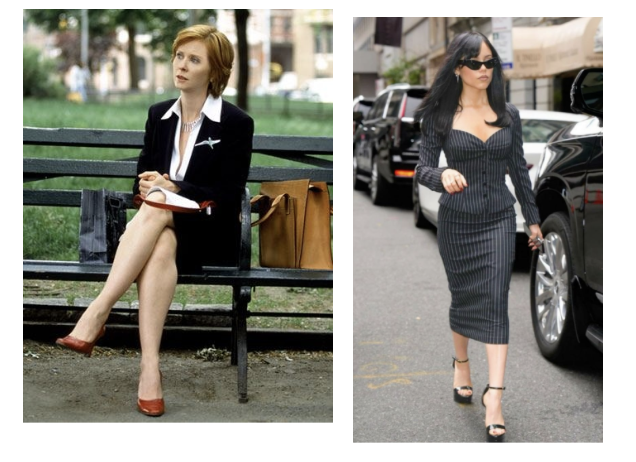How Sex and The City Still Influences How We Dress- Two Decades Later
Proof that good fashion—and great TV—never goes out of style.
Carrie, Charlotte, Samatha, and Miranda;the iconic four names who styled an entire generation. Darren Star’s Sex and the City (1998–2004), followed by its spin-offs and reboots, wasn’t just a show about dating in New York. It was a revolution in how fashion told stories. Patricia Field, the show’s costume designer, transformed each character’s wardrobe into its own storyline, one written in tulle skirts, power suits, pearls, and Manolo Blahniks. Two decades later, their looks still ripple through the fashion world, and into our own wardrobes.
Photo from Pinterest
Fashion Icon Carrie Bradshaw, The Experimental Maximalist:
This New York City writer of her column Sex and the City, is remembered for her fearless daring approaches to fashion. She set the standard for so many trends… from capris and tulle ballerina skirts to her iconic Dior Newspaper dress. Her influence extends far beyond the late 1990s and early 2000s. Today, the midi skirt and kitten heel pairing remains a street style staple, as do her signature polka dots, brooches, and headscarves. These pieces have become cyclical trends, continually resurfacing in both fast fashion and luxury runways. More than just inspiring outfits, Carrie normalized the idea that fashion could be deeply personal.It’s an extension of mood, identity, and storytelling. Ultimately, Carrie Bradshaw embodies the belief that fashion is not simply about what one wears, but how one chooses to live.and that choice, daring and unapologetic, continues to shape how women dress today.
Photos from Pinterest
Charlotte York, the Hopeless Romantic:
Charlotte is the romantic optimist of the show. She is known as the “Park Avenue Princess”, sporting boat and sweetheart neck lines, high buns, headbands and pearls. Her style very much stays consistent with her storyline in the reboot with her living in the Upper East Side twenty years later, fulfilling her dream of mothering her loving family. She is the epitome of traditionalism, especially in the early seasons. Through her quiet-luxury style and Upper East Side life, Charlotte reminds us that there’s no single blueprint for womanhood—every dream has its own validity.
Samantha, the Powerhouse:
Samantha’s wardrobe is tokened by her bold silhouettes, vibrant colors, eclectic patterns, and her iconic pantsuits. Samantha’s style is specifically meant to broadcast independence and authority, to compliment her character’s personality. Her unapologetic embrace of statement pieces whether in the boardroom or the bedroom, acts as a refusal to be constrained by social expectations of how women should dress or behave. As the show’s most openly feminist and sexually liberated figure, Samantha communicates her worldview through fashion as much as through words. The sharp tailoring of her pantsuits aligns her with more “masculine” coded power, while her daring use of plunging necklines, metallic fabrics, and extravagant accessories emphasizes her ability to reclaim femininity on her own terms. Her wardrobe blurs the line between professional authority and sexual expression, resisting the dichotomy that women must choose between the two.
Miranda, the Realist:
Miranda,a career-driven lawyer in the city, is the most androgynously-styled character of the four women. Her blazers, dress pants, loafers, and pixie cut shown that clothes are not inherently gendered. Her character, too, resists traditional gender norms more overtly than Charlottes does. Miranda prioritizes her career, and this personality and set of goals is very much reflected in her minimalistic. However, what we at The Elove so much about this show is how SATC presents these contrasting archetypes not in opposition, but as equally valid expressions of femininity.
Sex and the City was more than a TV show. It showed women how important individuality is in fashion- these women didn’t follow the rules. They made their own. In the words of the show’s legendary designer, “I wanted to communicate the idea that women can discover their own originality in the way they dress themselves," says Field. “Women identified with the four individual characters, and tended to pick up iconic cues from their styles. I continued to present edited ideas, always focusing on the character identity." “SATC gave women a chance to openly express what they were going through and what they were thinking," says the show's illustrious fashion designer, Patricia Field, who famously paid only $5 for that opening credits tulle skirt. “It was liberating to achieve this. It was a show that put women on the center stage." Carrie, Charlotte, Samantha, and Miranda teach us that we mustn’t stay in the confined boxes of trendsetting that is taught to us, but rather treat fashion as an art and form of self expression. We at The Edge urge you to take advantage of that and embrace your uniqueness.
-> Are you a Carrie, Miranda, Samantha, or Charlotte? What trends do you still wear the most? Let us know at @theedgemag!




